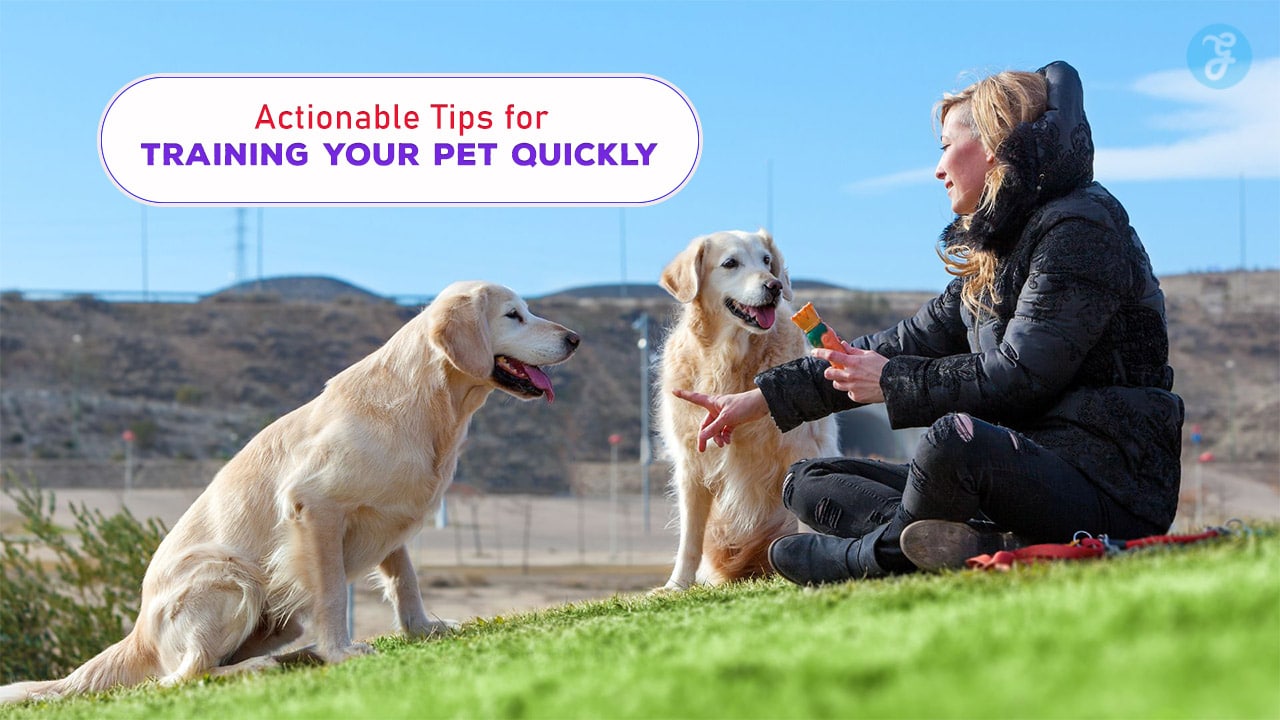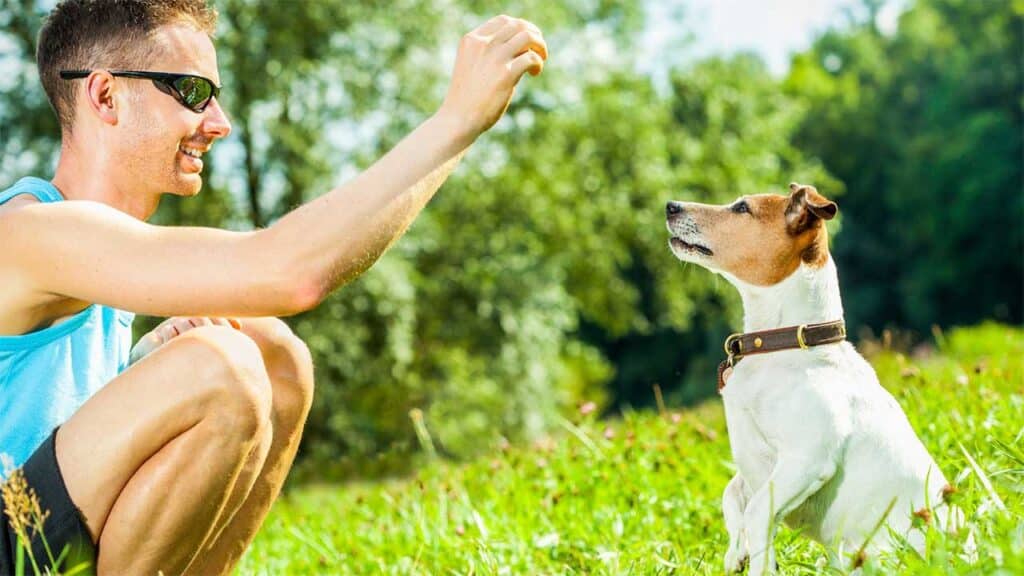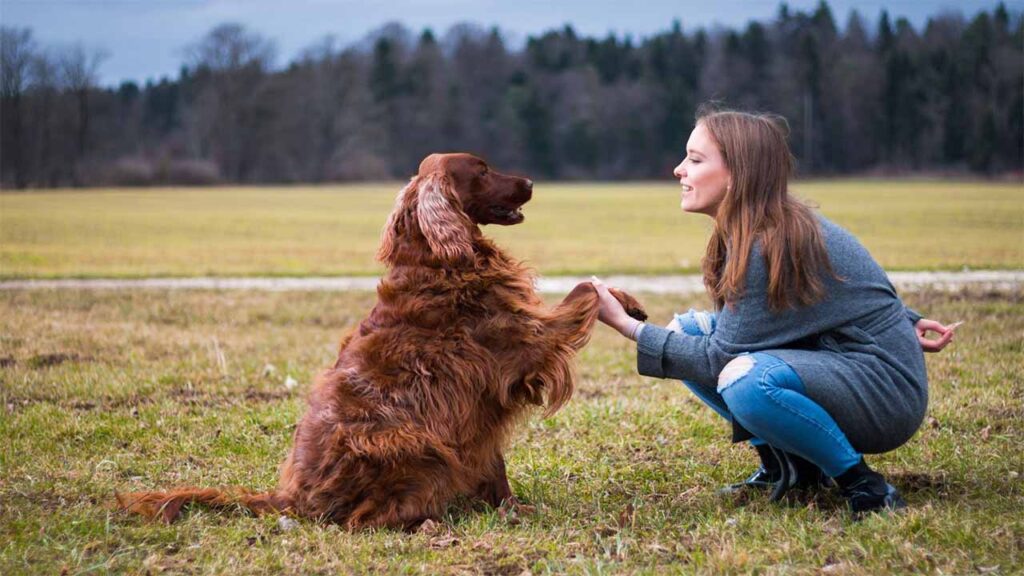Training your pet can be a rewarding experience. It helps build a strong bond between you and your furry friend. Many pet owners find the process challenging, but it doesn’t have to be.
You can train your pet quickly and easily with the right tips and tricks.
This article will show you 15 simple ways to get started with rapid pet training. Whether you have a new puppy or an older dog, these tips can help. You’ll learn how to teach basic commands and good behavior quickly.
1. UsePositiveReinforcement
Positive reinforcement is a great way to train your pet quickly. It focuses on rewarding good behavior instead of punishing bad behavior. This method helps build trust between you and your pet.
Rewards can be treats, praise, or toys. Choose something your pet likes. Give the reward right after your pet does what you want. This helps them connect the action to the reward.
Use a happy voice when you praise your pet. Smile and show you’re pleased. Your pet will pick up on your positive energy. This makes training more fun for both of you.
Be consistent with your commands. Pick one word for each action and stick to it. Say the command once and wait for your pet to respond. Don’t repeat it over and over.
Start with simple commands like “sit” or “stay”. Once your pet masters one, move on to the next. Keep training sessions short and fun. This keeps your pet interested and eager to learn.
Remember to be patient. Every pet learns at their own pace. Celebrate small wins along the way. With positive reinforcement, you’ll have a well-trained pet in no time.
2. MaintainConsistentTrainingSessions
Consistency is critical when training your pet. Set aside specific times each day for training sessions. Aim for short, frequent sessions rather than long, infrequent ones.
Keep your training schedule regular. Try to train at the exact times every day. This helps your pet learn to expect and focus during these periods.
Make sessions brief, around 5-10 minutes each. Short bursts are more effective than long, drawn-out lessons. Your pet will stay engaged and eager to learn.
Choose a quiet spot for training. Minimize distractions so your pet can concentrate on you and the task.
Use the same commands and hand signals each time. This helps your pet understand what you want more quickly.
Reward good behavior consistently. Use treats, praise, or toys your pet loves. This reinforces positive actions and encourages repeating them.
Be patient and persistent. Some days will be better than others. Keep at it, and you’ll see progress over time.
Get family members involved in training. Make sure everyone uses the same commands and rewards. This prevents confusion and speeds up learning.
End each session on a positive note. Always finish with something your pet can do well. This builds confidence and makes them look forward to the next session.
3. FocusonOneCommandataTime
When training your pet, it’s best to stick to one command at a time. This helps your furry friend learn more easily and quickly.
Pick a single command to work on, like “sit” or “stay.” Spend a few days focusing only on that command during your training sessions.
Give your pet plenty of chances to practice the chosen command. Use treats and praise to reward them when they get it right.
Keep training sessions short, around 5-10 minutes each. This prevents your pet from getting bored or overwhelmed.
Once your pet has mastered the command, you can move on to the next one. But don’t rush – make sure they’ve really got it down before adding something new.
Remember to use the same word and hand signal each time you give the command. This helps your pet understand precisely what you want them to do.
Be patient and keep at it. Some pets learn faster than others, but all can improve with consistent practice.
4. RewardGoodBehaviorImmediately
Timing is critical when training your pet. Give rewards right away when your pet does something good. This helps them connect the action with the reward.
Keep treats handy when working on new behaviors. Small, tasty treats work well for quick rewards. You can use pieces of cheese, cooked meat, or special dog treats.
Don’t forget that rewards can be more than food. Praise, petting, or a favorite toy can work too. Choose what your pet likes best.
Be consistent with rewards. Give them something positive every time your pet follows a command or shows good behavior. This reinforces what you want them to do.
Start with frequent rewards, then slowly reduce them as your pet learns. This helps the behavior stick even without constant treats.
Remember to use a happy, excited voice when praising your pet. Your tone matters just as much as the treat or toy you give them.
By rewarding good behavior right away, you make training more effective and enjoyable for both you and your pet.
5. KeepTrainingSessionsShort
Training your pet doesn’t have to take hours. Short sessions work best. Aim for 5 to 10 minutes at a time.
Dogs and cats have short attention spans. They get bored quickly. Long training can make them lose focus and get frustrated.
Break up training into small chunks throughout the day. This keeps your pet engaged and eager to learn. It’s better than one long, tiring session.
You can fit these quick sessions into your daily routine. Try training before meals or during playtime. This makes it fun and rewarding for your pet.
Remember, quality matters more than quantity. A focused 5-minute session can teach more than an hour of distracted training.
Keep it upbeat. End each short session on a good note. This leaves your pet wanting more and excited for the next training time.
6. UseClickerTraining
Clicker training is a fast and effective way to teach your pet new behaviors. It uses a small device that clicks to mark the exact moment your pet does something right.
To start, you’ll need a clicker and some tasty treats. Click the device and give your pet a treat right after. Do this a few times so they link the click with getting a reward.
Next, use the clicker to mark good behaviors. When your pet does what you want, click immediately and give them a treat. This helps them understand which action earned the reward.
For example, to teach “sit,” wait for your pet to sit independently. As soon as their bottom touches the ground, click and treat. Soon, they’ll start sitting more often to get the reward.
You can use clicker training for many behaviors, from basic commands to fun tricks. Always keep training sessions short and entertaining. End on a positive note so your pet stays excited to learn.
Remember to be patient and consistent. You and your pet will become an excellent clicker training team with practice.
7. IncorporatePlayandExercise
Playing with your dog is more than just fun. It’s a great way to train them, too. Games can teach your pet new skills and good behavior.
Try playing fetch with a ball or toy. This helps your dog learn to come when called. It also gives them exercise.
Use treats during playtime to reward good behavior. Give them a small treat when your dog follows commands like “sit” or “stay” during a game.
Make training sessions feel like play. Use a happy voice and lots of praise. Your dog will be more eager to learn this way.
Take your dog for walks or runs. This burns energy and makes them calmer for training later. A tired dog is often easier to teach.
Play tug-of-war, but set rules. Teach your dog to “drop it” on command. This helps them learn self-control.
Hide treats around the house or yard. Let your dog find them. This game teaches them to use their nose and follow your directions.
Remember to keep play sessions short. Dogs can get bored or tired if they last too long. Aim for 10-15 minutes at a time.
8. SocializeYourPetEarly
Start socializing your pet as soon as possible. For puppies, the critical window is between 3 and 16 weeks old. This is when they’re most open to new experiences.
Expose your pet to different people, animals, and environments. Take them to parks, busy streets, and pet-friendly stores. Let them meet people of all ages, sizes, and ethnicities.
Use positive reinforcement during socialization. Offer treats and praise when your pet encounters new things. This helps create good associations with new experiences.
Keep socialization sessions short and fun. Don’t overwhelm your pet. If they seem stressed, take a break and try again later.
Arrange playdates with other friendly pets. This helps your pet learn proper social skills and how to interact with other animals.
Enroll in puppy classes or basic obedience training. These provide structured opportunities for socialization and learning.
Teach your pet to be comfortable with handling. Touch their paws, ears, and mouth regularly. This makes vet visits and grooming easier.
Expose your pet to different sounds and surfaces. Play recordings of everyday noises like thunderstorms or fireworks. Walk them on various textures like grass, concrete, and metal grates.
Remember, socialization is an ongoing process. Continue exposing your pet to new experiences throughout their life to maintain their social skills.
9. ProvideClearCommands
When training your pet, clear commands are crucial. Use short, simple words that are easy to understand. Pick words like “sit,” “stay,” or “come” for basic instructions.
Say commands in a firm, confident voice. Your tone should be neutral, not angry or excited. Speak loudly enough for your pet to hear, but don’t shout.
Use the same word each time for a specific action. If you say “down” to make your pet lie down, stick with it. Don’t switch to “lie down” or “get down” later.
Pair your words with hand signals. This helps your pet understand better. For example, point to the ground when you say “sit.
Give one command at a time. Wait for your pet to respond before moving on. This prevents confusion and helps your pet focus.
Reward your pet right away when they follow a command. Use treats, praise, or petting. This teaches them that obeying leads to good things.
Practice commands in different places. Start in a quiet room, then try the backyard or park. This helps your pet learn to listen anywhere.
10. BePatientandPersistent
Training a pet takes time. You can’t expect your dog to learn everything overnight. Stay calm and keep working at it day after day.
Pets learn at their own pace. Some may pick up new skills quickly, while others need more practice. Don’t get frustrated if progress seems slow.
Keep your training sessions short and fun. Aim for 5-10 minutes at a time. This helps your pet stay focused and eager to learn.
Repeat commands and exercises often. Regular practice helps your pet remember what they’ve learned. Try to work on training each day.
Celebrate small wins along the way. Did your dog sit when asked? Give lots of praise and a treat. This positive feedback encourages them to keep trying.
If one method isn’t working, try a different approach. Every pet is unique. What works for one might not work for another. Be willing to adjust your tactics.
Remember that setbacks are normal. Your pet may forget a command they knew yesterday. Just go back and practice it again. They’ll get it with time.
11. UseHigh-ValueTreats
High-value treats can make a big difference in your pet’s training. These special treats are extra tasty and exciting for your pet.
Choose small, soft treats that your pet can eat quickly. This lets you give lots of rewards without overfeeding.
Try different treats to find what your pet loves most. Some pets go wild for tiny bits of cheese or meat. Others might prefer special training treats from the pet store.
Use high-value treats when teaching new or complex skills. They help keep your pet focused and motivated.
Save the best treats for the most demanding tasks. This makes your pet more eager to learn challenging things.
Mix up the treats you use. Surprise your pet with different rewards to keep training fun and interesting.
Remember to adjust your pet’s regular meals when using lots of treats. You don’t want them to gain too much weight during training.
12. AvoidPunishment
Punishment doesn’t work well for training your pet. It can make your dog scared or angry. Instead, focus on rewarding good behavior.
When your dog does something you don’t like, ignore it. Don’t yell or hit. These actions can harm your relationship with your pet.
Try redirecting your dog’s attention instead. If they’re chewing something, they shouldn’t give them a toy. This teaches them what they can chew on.
Positive reinforcement is critical. Give treats, praise, or pets when your dog does what you want. This makes them want to repeat the good behavior.
Remember, your dog isn’t trying to be wrong. They’re just being a dog. Be patient and kind as you guide them to better habits.
Consistency is important. Everyone in the house should use the same training methods. This helps your dog learn faster and avoid confusion.
13. TraininDifferentEnvironments
Training your pet in different places is essential. Your dog must learn to behave well everywhere, not just at home.
Start by practicing commands in your backyard. This helps your pet get used to distractions like smells and sounds.
Next, try training at a quiet park. Bring treats and use them to keep your dog’s attention. Reward good behavior often.
Gradually move to busier areas like busy streets or crowded parks. These places have more distractions, so be patient.
Practice in various indoor locations, too. Visit pet-friendly stores or friends’ houses. This teaches your dog to listen in new settings.
Keep training sessions short in new places. Your pet might get overwhelmed at first. Aim for 5-10 minutes at a time.
Always use the same commands and hand signals, no matter where you are. This helps your dog understand what you want.
If your pet gets distracted, move to a quieter spot. Then, try again when they’re calm and focused.
Remember to praise and reward your dog for good behavior in new places. This builds their confidence.
With practice, your pet will learn to follow commands anywhere. This makes outings more fun and stress-free for both of you.
14. TeachBasicCommandsFirst
Start your pet’s training with simple commands. These are the building blocks for good behavior. Focus on “sit,” “stay,” “come,” and “down” at first.
Begin with “sit.” Hold a treat close to your pet’s nose. Slowly move it up and back. As their head follows, their bottom will naturally lower. Say “sit” and give the treat when they do.
For “stay,” have your pet sit. Hold your hand up, palm facing them. Say “stay” and take a step back. Suppose they don’t move, praise, and treat them. Gradually increase the distance and time.
To teach “come,” say your pet’s name followed by “come.” Use an excited voice and offer a treat. When they reach you, give lots of praise and a treat.
“Down” can be trickier. Start with your pet sitting. Hold a treat near their nose, then slowly lower it to the ground. As they follow, their body should lower, too. Say “down” when they’re fully on the ground.
Keep training sessions short, about 5-10 minutes. Practice often, a few times a day. Always use positive reinforcement. Treats, praise, and petting work well.
Be patient and consistent. Every pet learns at their own pace. Stick with it, and you’ll see progress.
15. MonitorYourPet’sHealth
Keeping an eye on your pet’s health is critical to successful training. A healthy pet learns faster and responds better to commands.
Watch for changes in your pet’s eating habits. Are they eating more or less than usual? This could signal health issues that affect training.
Check your pet’s energy levels. If they seem tired or sluggish, it may be hard for them to focus on learning new tricks.
Look at your pet’s coat and skin. A dull coat or itchy skin might mean they’re not feeling their best, which can impact training sessions.
Pay attention to your pet’s bathroom habits. Changes could point to health problems that need addressing before training can progress.
Notice any shifts in your pet’s mood or behavior. These may be signs of discomfort or illness that could hinder training efforts.
Regular vet check-ups are essential. They can catch issues early, keeping your pet healthy and ready to learn.
A balanced diet helps your pet stay fit and alert during training. Ask your vet about the best food for your pet’s needs.
Exercise is crucial for your pet’s health and training success. Make sure they get enough physical activity each day.
Understanding Your Pet’s Learning Style
Pets learn in different ways, just like people. Knowing how your pet learns best can make training faster and easier. Let’s explore why learning styles matter and how to spot them in your pet.
Importance of Learning Styles
Learning styles affect how quickly your pet picks up new behaviors. Some pets learn best by watching. Others need to try things out themselves. Matching your training to your pet’s style can speed up progress. It also makes training more fun for both of you.
Using the right approach can prevent frustration. Your pet will feel more confident and eager to learn. This leads to better results in less time. You’ll see faster improvement in problem behaviors, too.
Identifying Different Learning Styles
Watch how your pet acts to figure out their learning style. Visual learners pay close attention when you show them what to do. They may copy other pets easily. Hands-on learners like to try things out. They learn by doing and may seem impatient to get started.
Some pets are sensitive to sounds and respond well to voice commands. Others focus more on body language or hand signals. Try different methods to see what works best. Does your pet perk up at your voice or watch your movements closely?
Pay attention to what motivates your pet, too. Some are food-driven, while others prefer praise or play. Use these preferences to make training more effective and fun.
Effective Training Techniques
Training your pet can be simple and fun. These techniques will help you teach your pet quickly and easily.
Positive Reinforcement
Positive reinforcement is critical to fast training. Give treats, toys, or praise when your pet does what you want. This makes them want to repeat good behaviors. Start with easy tasks and work up to harder ones. Keep training sessions short, about 5-10 minutes. This keeps your pet focused and happy.
Use a happy voice when your pet does well. Ignore bad behavior instead of punishing. Punishment can make pets scared or angry. Always reward your pet right after they do something good. This helps them connect the action to the reward.
Consistent Commands
Use the exact words and hand signals every time. This helps your pet understand what you want. Pick short, clear commands like “sit,” “stay,” or “come.” Say commands in a firm, friendly voice. Don’t yell or sound angry.
Practice commands in different places. This helps your pet learn to listen anywhere. Start in quiet spots and move to busier areas as your pet improves. Be patient and keep training fun. If your pet gets confused, go back to a more straightforward step. Repeat commands often, even when not training. This keeps your pet’s skills sharp.
Creating a Routine
Making a routine helps your dog learn faster. It sets precise training and play times, letting your dog know what to expect.
Establishing a Schedule
Pick set times each day for training. Aim for 5-10-minute short sessions, 2-3 times daily. Train when your dog is awake and eager to learn. Right after meals or walks often works well.
Write down your schedule and stick to it. You might train:
- 7:30 AM after breakfast
- 12:30 PM after lunch walk
- 6:30 PM before dinner
Keep sessions brief to match your dog’s attention span. Young pups may only focus for 1-2 minutes at first.
Balancing Training and Play
Mix up training with fun activities. This keeps your dog happy and excited to learn. Try this split:
- 5 minutes training
- 10 minutes play
- 5 minutes training
Use toys or treats as rewards during training. This makes it feel like a game. Take breaks if your dog gets tired or bored. End sessions on a good note with an easy task your dog can do well.
Make training part of daily life, too. Ask for a “sit” before meals or a “stay” before going outside. This helps your dog practice all day long.
Final Thoughts
Training your pet is a journey that requires patience, consistency, and understanding. The 15 actionable tips outlined in this article provide a comprehensive toolkit for effective and efficient pet training.
From using positive reinforcement to creating a consistent routine, these strategies are designed to help you build a strong, positive relationship with your furry companion while achieving your training goals.
Remember that every pet is unique, with its own learning style and pace. The key to success lies in adapting these techniques to suit your pet’s needs and personality.






































